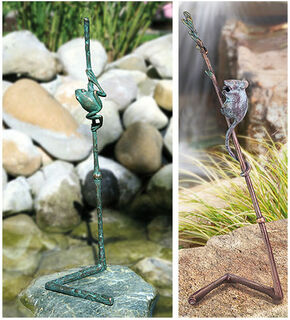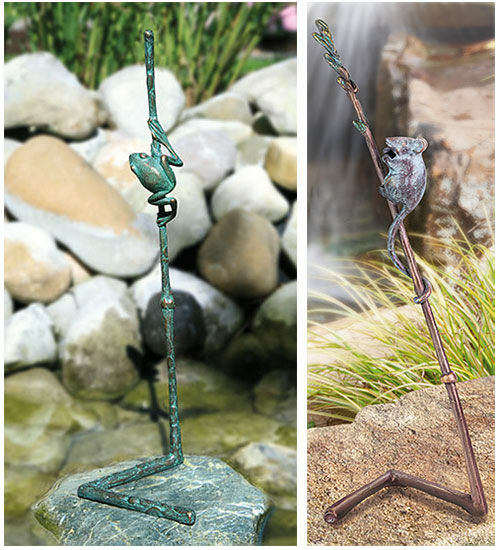Quick info
bronze | hand chased and patinated | frog: size 32 x 9 x 9 cm (h/w/d), weight approx. 0,2 kg | mouse: size 35 x 14 x 11 cm (h/w/d), weight approx. 0,5 kg | incl. mounting hardware
Detailed description
Set of 2 garden sculptures "Stalk with Frog / Stalk with Mouse", bronze
Bronze sculptures cast using the Lost-Wax-Process, chiselled and patinated by hand.
"Stalk with frog":
The climbing frog is, according to myths, an unmistakable sign of good weather. Size 32 x 9 x 9 cm (h/w/d). Weight approx. 0,2 kg. Can be fastened using the threaded pin supplied.
"Stalk with mouse":
Sometimes the path to the treasured grain requires acrobatics. With a focused gaze fixed on the goal, the mouse slowly but steady pushes forward, with its long tail wrapped around the stalk as support. Size 35 x 14 x 11 cm (h/w/d). Weight approx. 0,5 kg.
Set of both sculptures.
This set contains the following products
An alloy of copper with other metals (especially with tin) used since ancient times.
When casting bronze, the artist usually applies the lost-wax technique which is dating back more than 5000 years. It's the best, but also the most complex method of producing sculptures.
First, the artist forms a model of his sculpture. It is embedded in a liquid silicone rubber mass. Once the material has solidified, the model is cut out. The liquid wax is poured into the negative mould. After cooling down, the wax cast is removed from the mould, provided with sprues and dipped into ceramic mass. The ceramic mass is hardened in a kiln, whereby the wax flows out (lost mould).
Now we finally have the negative form, into which the 1400° C hot molten bronze is poured. After the bronze had cooled down, the ceramic shell is broken off and the sculpture is revealed.
Now the sprues are removed, the surfaces are polished, patinated and numbered by the artist himself or, to his specifications, by a specialist. Thus, each casting becomes an original work.
For lower-quality bronze castings, the sand casting method is often used which, however, does not achieve the results of a more complex lost-wax technique in terms of surface characteristics and quality.
A plastic work of sculptural art made of wood, stone, ivory, bronze or other metals.
While sculptures from wood, ivory or stone are made directly from the block of material, in bronze casting a working model is prepared at first. Usually, it is made of clay or other easily mouldable materials.
The prime time of sculpture after the Greek and Roman antiquity was the Renaissance. Impressionism gave a new impulse to the sculptural arts. Contemporary artists such as Jorg Immendorf, Andora, and Markus Lupertz also enriched sculptures with outstanding works.




